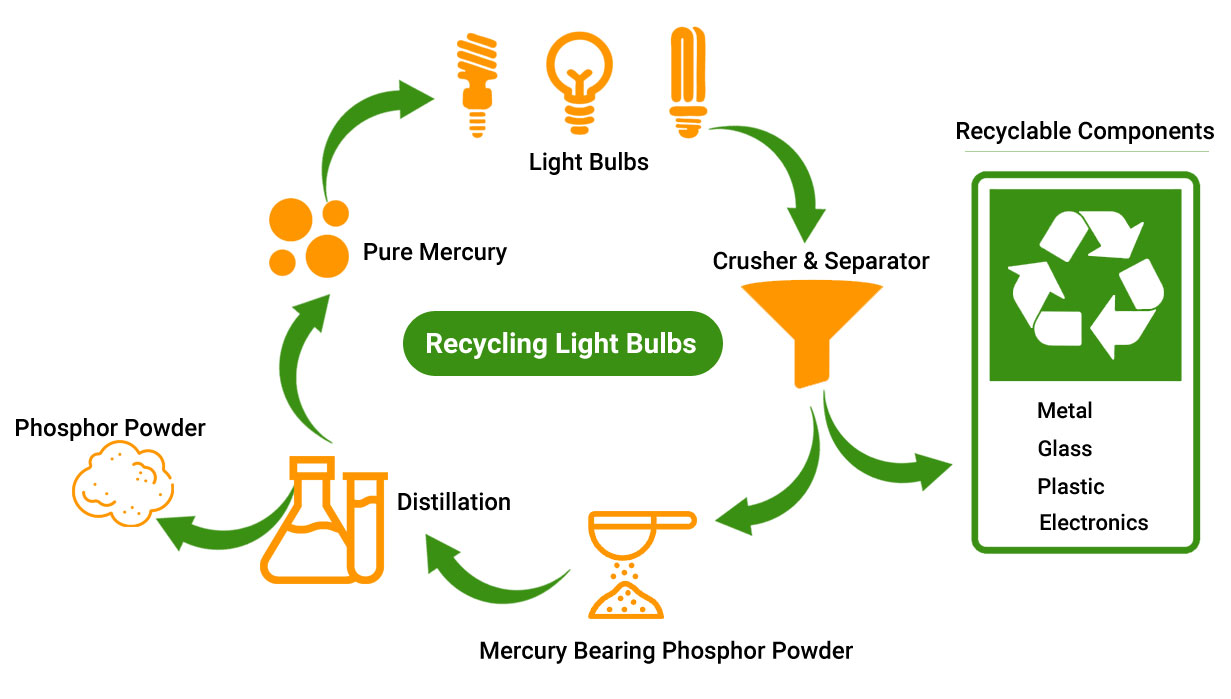Replaced your burnt-out bulb with the new one? Wondering what to do with the old one? Just toss it in the trash, right? Well, hold on a sec! It turns out those little light bulbs can have a bigger impact than you might think. Let's discuss about recycling and disposal of light bulbs – it's easier than you think, and it can make a real difference for the environment. Being a reliable recycling center directory in the U.S., we are happy to shed some light on this important topic!
Main Reasons Why Used Light Bulbs Shouldn't Go in the Trash
- Environmental impact: Many light bulbs require special handling, as it contains harmful materials like mercury in CFL bulbs or phosphor powder in fluorescents. Throwing them away means these materials can end up in landfills, potentially leaking into the soil and groundwater. This can contaminate our drinking water and harm wildlife.
- Wasted resources: Some bulb components, like glass and certain metals, can actually be recycled! This saves energy and resources compared to making them from scratch.
By properly disposing of light bulbs, we can protect the environment and make use of valuable materials.The United States Environmental Protection Agency (EPA) recommends consumers to take advantage of available local options for recycling CFLs, fluorescent bulbs and other bulbs that contain mercury, rather than disposing of them in regular household trash.
Understanding the Different Types of Light Bulbs
Understanding the different types of light bulbs and their unique recycling requirements is key to making informed choices that benefit both the planet and our communities.
Common types include:
- Halogen bulbs (often used in spotlights and floodlights)
- Incandescent bulbs (traditional one with a filament inside a glass bulb)
- Compact fluorescent lamp (CFL) (a fluorescent tube filled with gas and a phosphor coating inside)
- Light Emitting Diode (LED) bulbs (uses a semiconductor to produce light)
- High Intensity Discharge (HID) lamps: (often used in streetlights and large indoor spaces)
- Smart bulbs (controlled remotely via smartphone apps or voice command)
These bulbs are often bought, considering factors such as energy efficiency, lifespan, color temperature, and specific lighting needs. Different types of light bulbs require different types of disposal.

Light Bulb Recycling Solutions
Recycling most light bulbs in the U.S. is easier than you think. First, check the bulb. Not all bulbs are created equal. Incandescent bulbs typically don't require special recycling. At the same time, CFLs and LEDs should be recycled due to their mercury content or other specialty materials.
- Find a Drop-off Location: Many options exist for responsible disposal:
- Retailer take-back programs: Major retailers or most home improvement stores often accept CFLs and sometimes LEDs for recycling.
- Community collection events: Check with your local municipality for hazardous waste collection days or permanent drop-off locations.
- Mail-in programs: Companies specializing in bulb recycling offer mail-in kits for a fee. This can be a convenient option for those with limited local options.
Recycling Programs Differ
Each type of light bulb is recycled differently and each state and municipality has different requirements and recycling programs in place. While your curbside pickup recycling program may accept LED light bulbs, it typically will not take incandescent or CFL bulbs that may contain hazardous chemicals like mercury. Many states have specific recycling programs available for these materials.
Tips for Safe Handling Light Bulbs
- Wear gloves to protect your hands from cuts and injuries
- Avoid applying excessive pressure to prevent breakage
- Store bulbs in a cool, dry place, out of reach of children
- Follow local guidelines for disposing of different types of bulbs
- Place broken bulbs in a sealed container
Choosing the right recycling center for light bulbs is important to ensure safe and environmentally responsible disposal. Look for a facility that specializes in handling various types of bulbs, including CFLs, fluorescents, and LEDs, as these often contain hazardous materials like mercury. Ensure that the center complies with local and federal environmental regulations and has proper certifications.
Light Bulbs Recycling Process

